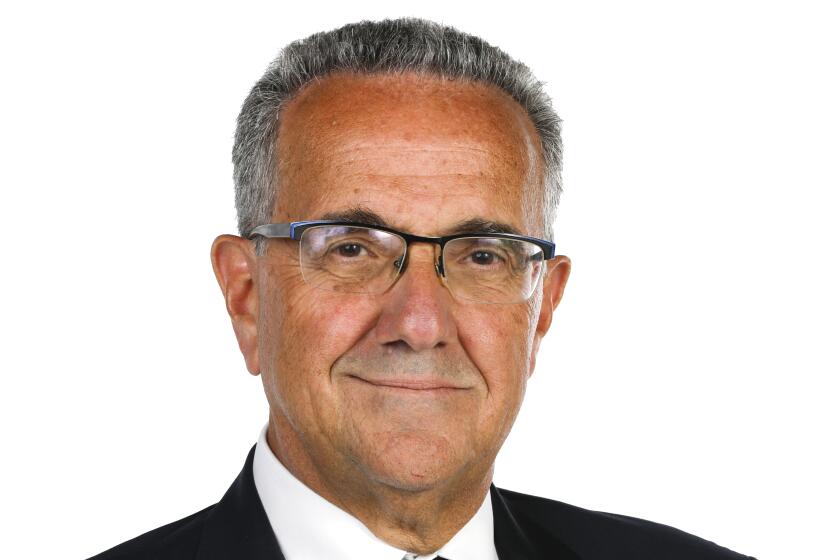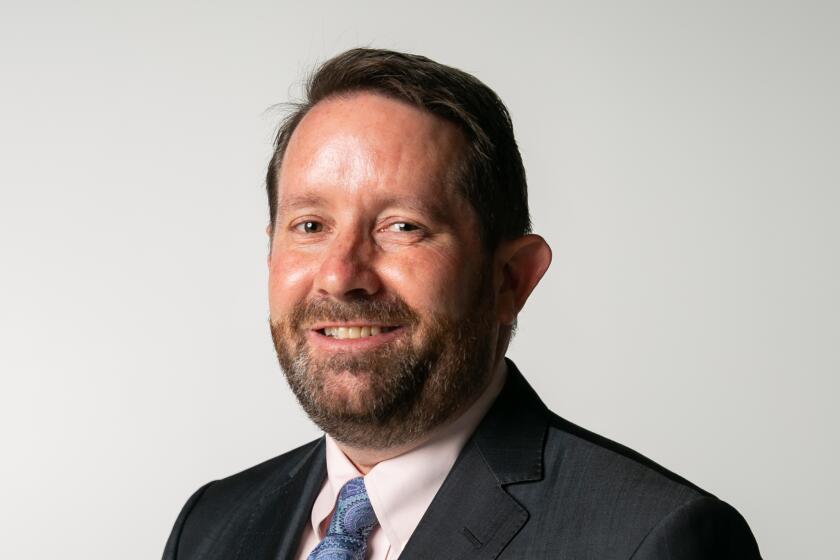2020 election: Q&A with Will Moore candidate for San Diego City Council District 1

The San Diego Union-Tribune Editorial Board recently emailed a series of questions to Democrat Will Moore, who is running for San Diego City Council District 1 against Democrat Joe LaCava.
Combined with flu season, the pandemic may pose even greater problems for San Diegans this winter. How will you balance public health and the economy if shutdowns are needed?
This idea that there’s some either/or choice between public health and the economy is simply ridiculous. Public health is the economy. Lots of people getting sick and dying is bad for the economy. A virus that we can’t vaccinate against, cure or even reliably treat, spreading freely in our community, is bad for the economy.
The short-term economic effects of limiting our interactions so that we can get the virus under control are hard. But the last six months have proven — the costs of failing to get the virus under control are much worse.
I am very upset that we have as many as 40 percent of our restaurants perhaps permanently going out of business. The restaurant and entertainment sector was the hardest hit by the virus. But it was also the hardest hit by our country’s irresponsible and ineffective open/close/open/close response to the virus.
We could have gotten this thing under control months ago, but we chose not to in the name of short-term impatience. That has had a massive long-term cost.
But every day is a new chance to do it right. The good news is, we know it’s possible. Many other countries have controlled community spread and are mostly back open and functioning again. Our failure to get this virus under control has been both an economic nightmare, and a national security nightmare.
We are San Diego, California, in the United States of America. We’re a premier city in a world leading superpower. We can get this done.
How satisfied are you with the progress the city has made on its Climate Action Plan and how will you ensure its legally binding goals are met?
Climate is a major priority for me. That’s why it is the first word in my Climate-Housing-Jobs agenda.
I am not satisfied with our progress on climate — not at all. The Climate Action Plan seemed like a good idea a few years ago, because we thought it would result in meaningful climate action. But it flat out hasn’t.
So rather than ask about the Climate Action Plan, let’s ask: what steps can we take right now that reduce our region’s carbon emissions as significantly, quickly and feasibly as possible? We can do this all while improving our quality of life.
Having people living near where they work is the first step. We need housing near job centers and mixed-use developments. That way more people will be able to live their lives without having to spend an hour in the car every day.
Giving people the option to take transit is the next step. Most of us, as a practical matter, will have to still drive our cars around. But we should at least have the choice of some other safe, fast, effective and green way to get around our community.
Next, we need to take advantage of the massive opportunities for low-carbon energy resources. Solar costs continue to drop as fast as any energy cost ever has. As a city with 300 days of sunshine, we can and should continue to lead the adoption of rooftop solar, and integrate those opportunities into a cheaper and more secure energy grid.
Neighborhoods south of Interstate 8, including communities of color, don’t always get the funding or consideration wealthier communities to the north get. How will you address that?
San Diego has a long history of redlining and restrictive covenants that created the still-largely-segregated neighborhoods we have today. These policies were deliberate government policy, implemented explicitly and in plain sight.
We will have to be honest about that history in order to do anything about it — but for years that very recent history hasn’t even been a part of public discussion. We like to think we’re a better society than we were then, and this is an opportunity to prove it.
I have been to places within the city limits where the consequences of that history live on. Places where people live on dirt roads. Places where there are no grocery stores for miles. Places where there are not neighborhood parks. We can do better than that. The recently created Office of Race and Equity will help us on this, but it will also take a lot of courage, honesty and effort every day.
We will also have to take an honest look at where our worst infrastructure deficits are. I would never support underfunding a project or repair in a part of town considered well-off just because of its fancy reputation — things are crumbling in every neighborhood. And there are more than a few of them in my own district that I do plan to get fixed quickly.
But we have to admit that we need to direct resources to the places where our worst infrastructure deficits lie. And in many cases those will be parts of our city haunted by a long and continuing history of inequity.
How, specifically, will you address the high cost of housing in San Diego?
Housing is expensive in San Diego because we haven’t built enough homes for our own kids to live in in a generation and a half. In the short term, I will support responsible new short-term vaction rental regulations to make sure our hard-earned new housing stock actually ends up with San Diegans living in it. I also support continuing Mayor Kevin Faulconer’s focus on updates to our many-decades-old outdated community plans.
Further, I will support regulatory reform to bring down the cost of building new housing. For example, we should be calculating development fees based on square footage rather than units, so that we incentivize more naturally affordable construction. We should reform our byzantine permitting processes — we can preserve our community values and make this a well-thought out city without taking three to 10 years to get simple things built.
There is a lot of talk about the need for subsidized housing and deed-restricted affordable housing. And I support aggressively pursuing adding those very necessary levels to house our people.
But we should also recognize that subsidized or dedicated affordable housing is an emergency response. It is necessary to treat the acute immediate symptoms of our housing crisis, but it simply isn’t a practical or effective long-term solution.
To illustrate: right now our median-income residents, average people, can’t afford non-subsidized housing. And that means we have some much more severe structural problems than can be solved with government subsidies or fancy accounting.
What will homelessness in San Diego look like at the end of your four-year term?
We need to get homeless people off the street and into homes. Our homelessness crisis is not only immoral, it is economically disastrous for our city.
What will homelessness look like in four years? The sad but honest answer is: Unless we change course dramatically and build housing for people to live in, homelessness is likely to look about the same in four years.
If you have 10 people and nine places to live, one person is going to be out in the street — no matter what other brilliant non-housing programs we come up with. This is, at root, the tension behind the recent failure of the city’s navigation center — it didn’t have any housing to navigate people to!
We need permanent supportive housing for our most troubled people experiencing homelessness. But we also need housing that regular people can afford while just working one job. We have working people paying 50 percent or even 70 percent of their income in rent in this town. If something small goes wrong for a person in that situation, they are in the street.
We have spent too many years pretending that the end of homelessness is just a clever program or accounting trick away. That’s proven ineffective. It’s time to take housing seriously and get these folks off the street.
Will — and how will — you accept and evaluate Mayor Kevin Faulconer’s proposal to redevelop the sports arena site?
There’s not really a nice way to say it — the Midway is currently known for being a sketchy run-down blight and that needs to change as soon as possible.
But that terrible starting point, paradoxically, makes it the greatest immediate opportunity for progress in our region. Midway is close to our job centers in Downtown and in University City. It’s accessible to the coast. And it’s at a major transportation crossroads, both in the form of public transit and freeway access.
We should not underestimate or undersell Midway’s potential. The proposal to develop the sports arena site will set the tone for that.
I will be pushing for the most aggressive proposal that gets us the most dynamic Midway District possible in the shortest period of time. I personally preferred the proposal that the mayor passed over, but I’m currently not the mayor. And I don’t like to redo processes just because I don’t get my way. Mayor Faulconer’s approved proposal satisfies many of my goals, and I will push to improve that proposal within my powers as a council member.
If that proposal turns out to be legally flawed in some way, then I will push hard for a dynamic Midway District with a new process with a sense of urgency. The bottom line is that this city needs to get away from its addiction to endless committees and extra processes and redos, and get good things done. San Diego does not have time to dally as it builds its new future — especially in the Midway.
Read our Q&A with the other candidate in this race:
San Diego City Council District 1 candidate Joe LaCava on the pandemic, housing, climate and more.
Read our interview from the primary:
San Diego City Council candidate Will Moore met with The San Diego Union-Tribune Editorial Board ahead of the 2020 primary election.
Get Weekend Opinion on Sundays and Reader Opinion on Mondays
Editorials, commentary and more delivered Sunday morning, and Reader Reaction on Mondays.
You may occasionally receive promotional content from the San Diego Union-Tribune.






